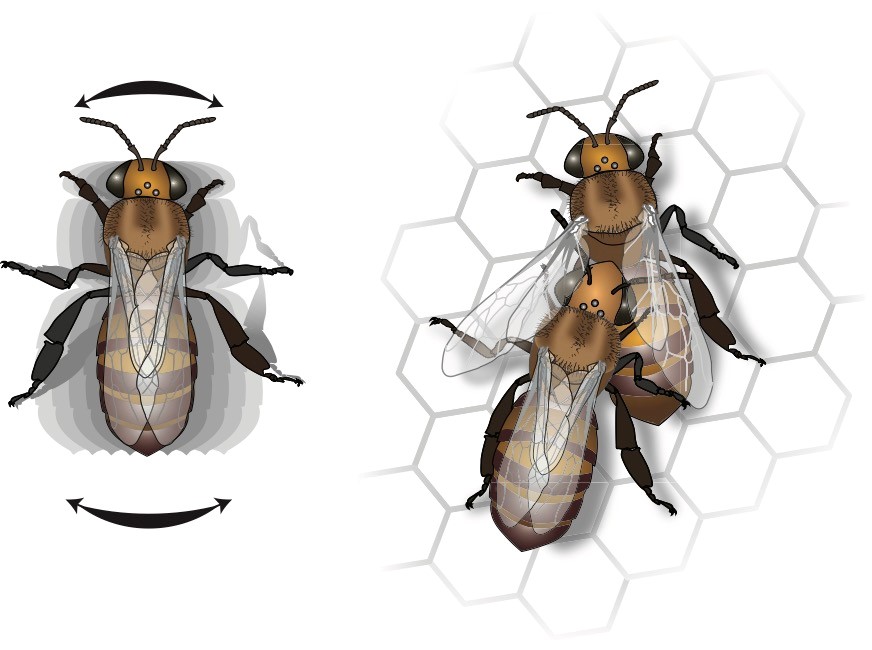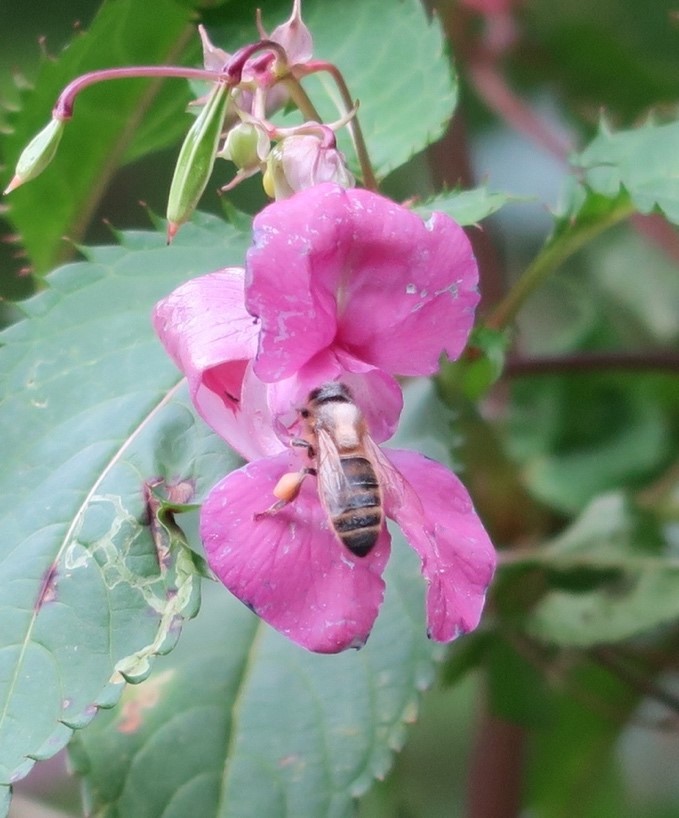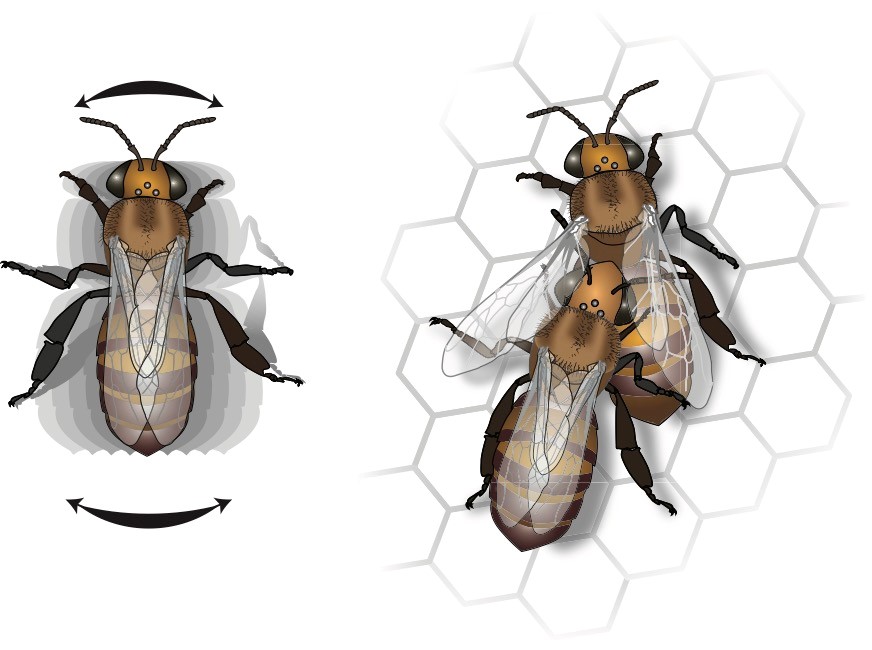
The Grooming Invitation Dance.
This week, Professor Tom Seeley gives us a fascinating detailed account of the grooming invitation dance in this exerpt from his latest uncoming book. Thank you for sharing this with Beelistener readers, Tom.
Good grooming is important for human beings, but it is indispensable for honey bees. These insects live crowded inside tree hollows, bee hives, and other tight spaces, so they must cope with a never-ending rain of wax bits, pollen grains, and other debris falling onto their bodies. Every beekeeper who has put a “sticky board” on the floor of a hive, perhaps to measure a colony’s level of infestation with Varroa mites, knows how much stuff falls down inside a colony’s home in just a day or two…. lots! The workers deal with this problem by grooming both their own bodies (“autogrooming”) and those of their nestmates (“allogrooming”).
A worker bees is certainly adept at autogrooming, but there are some surfaces on her body that she cannot clean thoroughly on her own. These include the rear surfaces of her head and the top surfaces of her thorax, especially the “hinges” at the bases of her wings. Bits of debris can get lodged in these hard-to-groom spots by accident, especially when a bee is inside the hive and bits of crud fall onto her. The same thing can happen to foragers when they are outside the hive. Indeed, some plants, such as Himalayan balsam (Impatiens glandulifera), have flower structures that deposit pollen in hard-to-groom spots by “design” (Fig. 1); doing so makes the bees more effective pollinators for these plants. So, there are times when worker bees sense that they need help with their grooming. They will then produce a strange-looking call for assistance: the grooming invitation dance.

Fig. 1. Honey bee collecting pollen from a flower of Himalayan balsam in Scotland. The anthers in this species’ flowers deposit their pollen deftly atop a worker bee’s thorax, where she cannot groom it off. The light strip atop her thorax shows this limitation.
To the best of my knowledge, the first detailed description of the grooming invitation dance was written by Professor Mykola H. Haydak. He was a Ukrainian scientist who came to the United States in 1930, earned his PhD at the University of Wisconsin in 1933, and then worked as a professor of entomology at the University of Minnesota until 1966. In the September, 1945 issue of the American Bee Journal, he published a lovely article titled “The language of the honeybees.” It includes a vivid description of the grooming invitation dance of a worker bee seeking assistance and of the response to it by fellow worker bees:
Occasionally a bee feels the need of being cleaned. In such cases it performs a special dance, consisting of a rapid stamping of the legs and a rhythmic swinging of the body to the sides. At the same time the bee rapidly raises and lowers the body and tries to clean around the bases of the wings with the middle pair of the legs. Such a “shaking” dance may be observed any time during the year, even during the winter. Usually the bee which is closest to the dancer touches the latter with its antennae and begins to clean the dancer. With the mandibles widely spread the “cleaner” touches the thorax of the dancer just under the bases of the wings. As soon as the dancer feels the touch of the cleaner, it stops dancing, slowly spreads out the wings of one side, bends the abdomen and curves the body to the side and somewhat upward as if accommodating the cleaner. The latter works very energetically. Its antennae are held close to the mandibles. With shearlike motions of the mandibles it cleans around the base of the wings. (1)
Haydak was not able to film the grooming invitation dance, so he was unable to make a precise description of the movements making up this behavior. Also, he did not investigate what causes a worker to perform this dance.
The most recent investigation of the form and function of the grooming invitation dance was made by an undergraduate student at Cornell University, Benjamin B. Land, who examined it further in 2002. (2) Ben made close-up, digital video recordings of bees producing this dance and then patiently analyzing the recordings using slow-motion playback.
Ben analyzed 25 grooming invitation dances. This work yielded several solid findings. First, it revealed that when a bee produces this dance, she does not walk across the comb like a waggle dancer. Instead, she stands rooted in one place with her six legs widely spread and with each leg’s tarsal claws gripping the comb. This stance makes sense; it prevents her from falling off the comb as she heaves her body mightily and rapidly (4 times per second) from side to side on the vertical surface of a comb (Fig. 2). Second, it confirmed that grooming invitation dances are short-lived. Their average duration is just 9 seconds. In comparison, waggle dances have an average duration of 60 seconds. Third, it showed that when a bee performs a grooming invitation dance, she may pause briefly to groom herself. Sometimes, she grooms her abdomen, by raising it and pivoting it sideways, and then brushing it with her hind legs. Other times, she grooms her head or thorax with her foreleg and middle legs. I suspect that when a bee makes a pause in her grooming invitation dance to groom herself, she is trying to remove something especially troublesome from her body. She can’t wait for help!

Fig. 2 Left: The grooming invitation dance. Right: the allogrooming response that it elicits. The grooming by another bee almost always involves the groomer mounting the groomee as soon as she has stopped dancing and has spread one or both wings. Note: when a bee grooms another bee, she (the groomer) tilts her head so her mandibles point forward instead of downward. This is why the heads of the groomed bee and the groomer bee look so different in the right-hand part of this figure.
Ben’s analyses of his video recordings also documented the effects of the grooming invitation dance on nearby bees. When Ben watched 65 bees that had performed this dance, he saw that 45 of them (69%) received allogrooming by adjacent bees within 30 seconds of the start of their dancing.
I close this piece with a speculation on the evolutionary origins of the grooming invitation dance. Because the form of this dance resembles the form of a worker bee’s behavior when she grooms herself, I suggest that the precursor (ancestral behavior) of the grooming invitation dance is the set of movements made by worker bees when they perform autogrooming. These movements are a reliable indicator (cue) that the bee making them senses that she needs grooming. Then, at some point in the past, workers probably evolved an allogrooming response to fellow workers that were grooming themselves especially strongly, i.e., to bees that were having great difficulty getting themselves clean. Since workers living together are nest mates, both the bees receiving the grooming and the bees giving the grooming will benefit from this social response. Thus the stage was set for natural selection to favor refinements both in signal production (exaggeration of the self-grooming behavior) and in signal reception (greater sensitivity to bees producing the self-grooming behavior). The eventual result was, I believe, the remarkable grooming invitation dance and the reliable allogrooming response that we can have fun watching today.
This blog is an excerpt from one of the chapters in Tom Seeley’s forthcoming (Spring 2024) book: Piping Hot Bees and Boisterous Buzz-Runners. Solving 20 Mysteries of Honey Bee Behavior. Princeton University Press.
If you enjoyed reading this, you can subscribe to receive future posts by email. Also, if this article helped you with your work, please consider making a small donation to keep our site running. You can do this through the “Donate with Paypal” button that appears at the side of the screen if you are using a desktop, or by scrolling towards the bottom of the page if you are using a mobile.
Thank you, Ann 🐝

Fascinating, thank you. I wonder if bumblebees do anything related?
Thank you, Philip, for letting me know you found fascinating this piece on how worker honey bees request help in grooming. Regarding bumble bees, I’ve not read anything about one bumble bee grooming another, so I suspect these bees don’t have a grooming invitation signal like that of honey bees. But I am not sure.
One thing that makes me suspect that bumble bees don’t have an analogous signal is that their combs tend to be more or less flat, not vertical as with honey bees. Having flattish combs leads me to suspect that a bumble bee worker, unlike a honey bee worker, does not experience lots of “crud” falling down onto her body. So perhaps bumble bee workers rarely suffer from gummed-up wing hinges. Maybe you could collect a bumble bee colony, put it in a glass-topped nest box, and have a look-see?